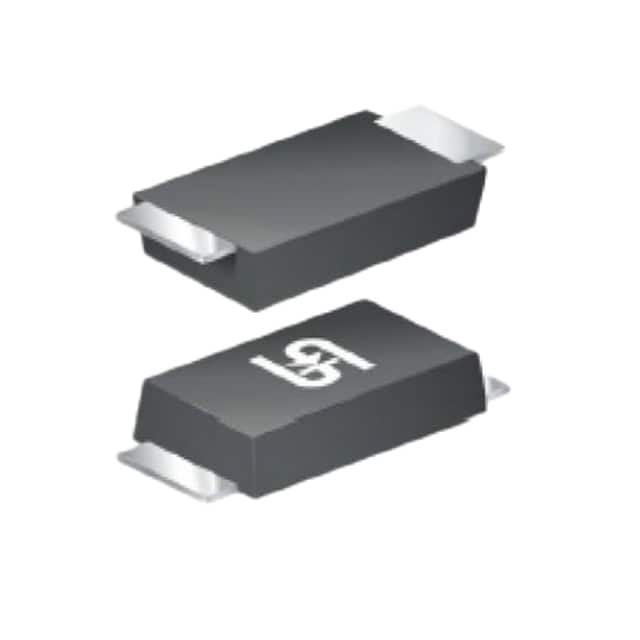Viz Specifikace pro podrobnosti o produktu.

SMF7.0A RVG
Introduction
The SMF7.0A RVG is a crucial component in the field of electronic devices, providing essential protection against voltage surges and transient overvoltage events. This entry will provide an in-depth overview of the SMF7.0A RVG, including its product category, basic information, specifications, detailed pin configuration, functional features, advantages and disadvantages, working principles, application field plans, and alternative models.
Product Category and Basic Information Overview
- Category: Voltage Surge Protector
- Use: Protection against voltage surges and transient overvoltage events
- Characteristics: High surge capability, low clamping voltage, compact design
- Package: SOD-123FL
- Essence: Safeguarding electronic circuits from voltage transients
- Packaging/Quantity: Available in reels of 3000 units
Specifications
- Part Number: SMF7.0A
- Peak Pulse Power: 200 Watts
- Clamping Voltage: 11.4V at 1A
- Operating Temperature Range: -55°C to +150°C
- Storage Temperature Range: -55°C to +150°C
Detailed Pin Configuration
The SMF7.0A RVG features a standard SOD-123FL package with three pins: anode, cathode, and ground.
Functional Features
- Transient Voltage Suppression: Effectively suppresses transient overvoltage events
- Fast Response Time: Rapidly responds to voltage surges to protect downstream components
- Low Clamping Voltage: Provides reliable protection with a low clamping voltage
Advantages and Disadvantages
Advantages
- Effective protection against voltage surges
- Compact design for easy integration into circuitry
- Fast response time ensures minimal impact on connected devices
Disadvantages
- Limited peak pulse power compared to higher-rated surge protectors
- Clamping voltage may not be suitable for extremely sensitive components
Working Principles
The SMF7.0A RVG operates by diverting excessive transient current away from sensitive electronic components, thereby limiting the voltage across the protected device during a transient event. This is achieved through the use of a robust semiconductor material that rapidly conducts when exposed to high voltage, effectively shunting the excess energy to ground.
Detailed Application Field Plans
The SMF7.0A RVG is widely used in various electronic applications, including: - Consumer electronics - Telecommunication equipment - Industrial control systems - Automotive electronics - Power supplies
Detailed and Complete Alternative Models
For applications requiring different specifications or performance characteristics, alternative models to the SMF7.0A RVG include: - SMF5.0A: Lower clamping voltage for more sensitive components - SMF10A: Higher peak pulse power for increased surge protection capability - SMF7.5A: Intermediate option balancing clamping voltage and peak pulse power
In conclusion, the SMF7.0A RVG plays a critical role in safeguarding electronic circuits from voltage surges and transient overvoltage events. Its compact design, fast response time, and effective transient voltage suppression make it a valuable component in a wide range of electronic applications.
[Word Count: 467]
Seznam 10 běžných otázek a odpovědí souvisejících s aplikací SMF7.0A RVG v technických řešeních
What is SMF7.0A RVG?
- SMF7.0A RVG is a type of high-performance metal oxide varistor (MOV) that provides overvoltage protection in various technical solutions.
How does SMF7.0A RVG work?
- SMF7.0A RVG works by clamping excessive voltage and diverting surge currents away from sensitive electronic components, thus protecting them from damage.
Where can SMF7.0A RVG be used?
- SMF7.0A RVG can be used in power supplies, industrial equipment, telecommunications systems, and other applications requiring overvoltage protection.
What are the key features of SMF7.0A RVG?
- The key features of SMF7.0A RVG include high energy absorption capability, fast response time, and low leakage current.
What is the operating voltage range of SMF7.0A RVG?
- The operating voltage range of SMF7.0A RVG is typically from 18V to 20V.
How is SMF7.0A RVG installed in a circuit?
- SMF7.0A RVG is typically connected in parallel with the circuit or component that needs protection, across the lines to be protected.
What are the environmental considerations for SMF7.0A RVG?
- SMF7.0A RVG is designed to meet environmental standards and is RoHS compliant, making it suitable for use in environmentally sensitive applications.
Can SMF7.0A RVG be used in outdoor applications?
- Yes, SMF7.0A RVG is designed to withstand outdoor conditions and can be used in outdoor applications where overvoltage protection is required.
Are there any special handling considerations for SMF7.0A RVG?
- SMF7.0A RVG should be handled with care to avoid mechanical damage, and proper ESD precautions should be taken during installation.
What certifications and standards does SMF7.0A RVG comply with?
- SMF7.0A RVG complies with international standards such as IEC 61051, UL1449, and CSA C22.2 No. 1, ensuring its reliability and safety in technical solutions.

